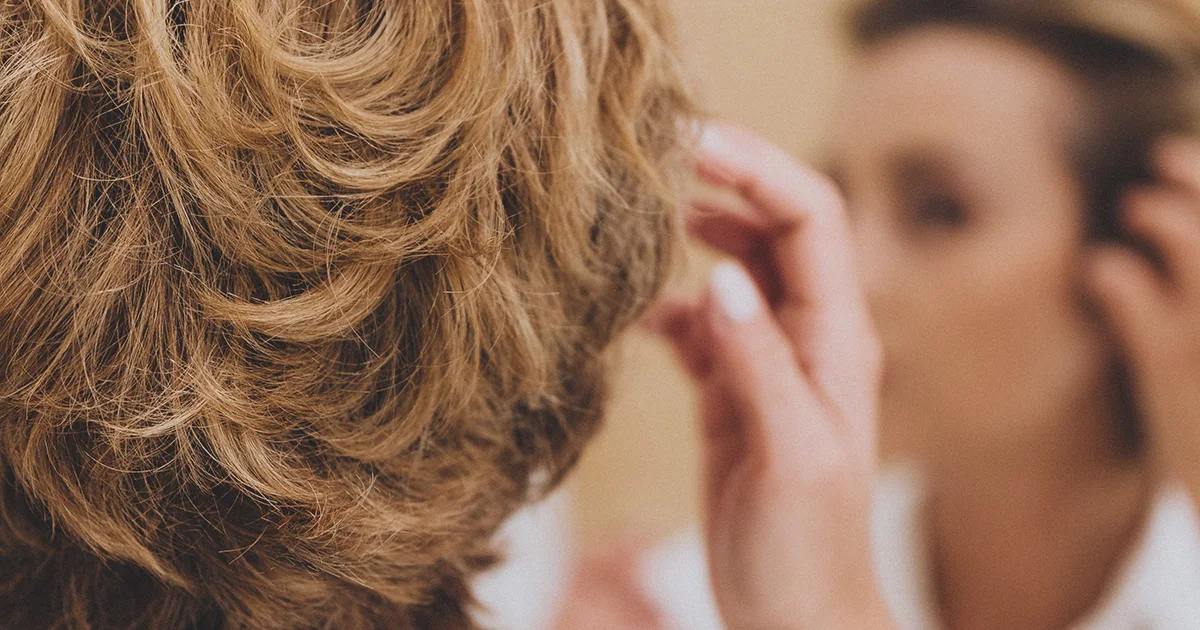Here's what we'll cover
Here's what we'll cover
Here's what we'll cover
Did you know that everyone experiences hair loss to some degree? We all lose up to 100 hairs a day as part of a normal hair life cycle. But, there are people who lose more hair than they grow back, which is called alopecia. Male pattern baldness is the loss of hair on the scalp that commonly affects men, and it’s referred to as androgenic alopecia. While it’s more common in men over the age of 50, men under 30 experience it too.
What is male pattern baldness?
Androgenic alopecia is the leading cause of hair loss among men and up to half of men experience it by the age of 50. When you have male pattern baldness, you’ll notice thinning on the top of the head or the sides of the scalp, and you’ll also see a receding hairline. Male pattern baldness is genetic and rises as men age, which has to do with hormone changes (Ho, 2021).
It’s important to remember that while male pattern hair loss is the most common form of alopecia, hair loss isn’t always genetic. Many factors can cause alopecia, including illness like thyroid disease and iron deficiency anemia, stress, diet, medications, and certain hair care habits (Phillips, 2017; Ho, 2021).
What causes male pattern baldness?
Androgenic alopecia, or balding, is genetic. Most men have a family history of androgenic alopecia, so having a close family member with this type of hair loss increases your risk of male pattern baldness.
Male pattern baldness is linked to male hormones (androgens), specifically dihydrotestosterone (DHT). Androgens are important for healthy male sexual development and also seem to regulate hair growth in both men and women (yes, women can experience androgenic alopecia, too). How do androgens affect hair growth? Well, hair grows from special structures under the skin called follicles. Approximately 90% of your hairs are in the active growing phase (anagen) and stay there for two to six years. The hairs then go into a transition phase (catagen) for one to two weeks. Lastly, each hair enters the resting (telogen) phase for two to four months. At the end of the resting period, the hair falls out, and the follicles return to the growth phase to start again.
In male-pattern baldness, increased levels of androgens in the follicles are believed to shorten the hair follicle’s life cycle, producing shorter and thinner hair strands. Some follicles eventually slow down and stop making hair altogether. Hormone levels change with age, which is likely why male pattern baldness becomes more common with age (Phillips, 2017).
Risk factors for androgenic alopecia
The two main risk factors for androgenic alopecia are genes and age.
As noted above, your genes play a significant role in your risk of developing androgenic alopecia. If your father, for example, experienced balding, you are 5–6 times more likely to experience male pattern baldness (Ho, 2021).
Then, there’s age. In some cases, male pattern baldness can start early—some studies show that it affects up to 16% of men between 18-29. But it’s way more common in older men, with the likelihood increasing with age. White men are most affected, with 50% of men showing signs of balding by age 50 (Rhodes, 1998; Phillips, 2017).
Male pattern baldness symptoms
Men often experience the classic male pattern baldness with androgenic alopecia. That means you lose the hair on the top of the scalp and the hair above the temples. The hair starts to be finer and then eventually stops growing in specific areas. This is a gradual process. You may see a receding hairline in an M shape or an exaggerated “widow’s peak.” Sometimes, male pattern baldness progresses to partial or complete baldness (Phillips, 2017).
How to treat androgenic alopecia
There is no cure for male pattern baldness. However, some therapies can slow or even partially reverse the process for a time. Some men prefer to embrace their baldness, which is a natural part of aging as a man. For others, the hair loss causes psychological distress, and they may turn to medications, surgery, or ways to camouflage the balding.
There are two FDA-approved medications for treating hair loss from androgenic alopecia: minoxidil and finasteride.
Minoxidil (Rogaine)
Minoxidil (brand name Rogaine) works on the hair follicles on the top of the head and promotes hair growth. It is available over-the-counter, and you apply it directly to your scalp twice a day. It can take three to six months for you to see results, and you need to use it continuously because once you stop, your hair loss will return within three to four months (Suchonwanit, 2019).
It is the only FDA-approved medication for androgenic alopecia in both men and women, and the most common side effects are mild and include itching or irritation after application.
Finasteride (Propecia)
Finasteride (brand name Propecia; see Important Safety Information) is a prescription medication taken by mouth that slows baldness and hair loss in many men (AAD, n.d). It works by reducing how much DHT is made, thereby decreasing its effect on the hair follicles. Although we often think of finasteride as a hair loss drug, it was a treatment for benign prostatic hyperplasia (BPH), or enlarged prostate, first (Zito, 2020). Today, it’s used just as commonly to treat hair loss as it is for BPH.
It may take several months to see results while taking finasteride for hair loss, and just like minoxidil, if you stop taking it, your hair loss will return (Zito, 2021).
Women and children should not take finasteride, and pregnant women should not touch any broken tablets because of the risk of birth defects.
Hair transplant surgery
Hair transplantation is the most invasive treatment for hair loss. It involves surgery to physically move hair follicles from one part of your scalp to the area of hair thinning.
The surgeon takes hair from part of the scalp with good hair growth and moves it to thinning or balding areas. On average, 700-1500 follicular units are transplanted during the surgery (Bicknell, 2014).
In the first three to four months after a hair transplant, you may notice your hair looking thinner; this is because the transplanted hairs fall out, and then the new hairs start growing. Full hair restoration can take 6-12 months. Afterward, most people continue to use medications like minoxidil or finasteride to prevent further hair loss (Bicknell, 2014). Healthcare providers usually reserve hair transplant surgery for people who have already tried medical treatment without success.
Cosmetics and camouflage
Some men choose to use cosmetic means to camouflage the balding areas. These options include wigs or hairpieces; hairstyle changes or shaving the scalp; concealing powders or lotions to decrease the contrast between the scalp skin and the thinning hair to give the illusion of a thicker head of hair; and micropigmentation, or tattooing, of the scalp
Other male pattern baldness treatments
Other procedures may benefit people with male pattern baldness; their effects have not been definitively proven, and more research is needed. These procedures include:
Low-level laser therapy (LLLT): The FDA has approved low-level light therapy devices (combs, helmets, and other devices) to treat both male and female pattern hair loss, but there is a need for more research in this area (Dinh, 2007).
Microneedling: This is also an FDA-cleared medical device for treating hair loss. Small puncture wounds created by tiny needles in the outer layers of the skin of the scalp are thought to encourage hair regrowth by triggering a wound healing response. A few small studies show that it can help hair regrowth, especially when paired with hair-growth-promoting remedies (Fabbrocini, 2018)
Platelet-rich plasma (PRP): After taking your blood and separating the plasma from the red and white blood cells, your provider will inject it into the skin in areas of hair loss. Early clinical results are promising, but there is a need for more research to determine the effectiveness of this treatment in female pattern hair loss (Fabbrocini, 2018).
Oral Minoxidil Important Safety Information: Read more about serious warnings and safety info.
Finasteride Important Safety Information: Read more about serious warnings and safety info.
Preventing male pattern baldness
In the case of inherited male pattern baldness, there isn’t much research out there about avoiding, preventing, or curing androgenic alopecia. But, reaching out to a healthcare provider can help you seek treatments, like the medications listed above, that may slow down your hair loss.
DISCLAIMER
If you have any medical questions or concerns, please talk to your healthcare provider. The articles on Health Guide are underpinned by peer-reviewed research and information drawn from medical societies and governmental agencies. However, they are not a substitute for professional medical advice, diagnosis, or treatment.
References
American Academy of Dermatology (AAD). (n.d.). Hair Loss: Diagnosis and Treatment . Retrieved Oct. 2, 2019 from https://www.aad.org/public/diseases/hair-loss/treatment/diagnosis-treat
Bicknell, L. M., Kash, N., Kavouspour, C., & Rashid, R. M. (2014). Follicular unit extraction hair transplant harvest: a review of current recommendations and future considerations. Dermatology Online Journal , 20 (3). Retrieved from https://pubmed.ncbi.nlm.nih.gov/24656268/
Dinh, Q. & Sinclair, R. (2007). Female pattern hair loss: Current treatment concepts. Clinical Interventions in Aging, 2 (2). 189–199. Retrieved from https://www.ncbi.nlm.nih.gov/pmc/articles/PMC2684510/
Fabbrocini, G., Cantelli, M., Masarà, A., Annunziata, M., Marasca, C., & Cacciapuoti, S. (2018). Female pattern hair loss: A clinical, pathophysiologic, and therapeutic review. International Journal Of Women's Dermatology , 4 (4), 203-211. doi: 10.1016/j.ijwd.2018.05.001. Retrieved from https://pubmed.ncbi.nlm.nih.gov/30627618/
Ho, C., Sood, T., & Zito, P. (2021). Androgenetic Alopecia. [Updated Aug 11, 2021]. In: StatPearls [Internet]. Retrieved from https://pubmed.ncbi.nlm.nih.gov/28613674/
Murphrey, M. B., Agarwal, S., & Zito, P. M. (2019). Anatomy, Hair. [Updated Aug 11, 2021]. In: StatPearls [Internet]. Retrieved from https://www.ncbi.nlm.nih.gov/books/NBK513312/
Phillips, T. G., Slomiany, W. P., & Allison, R. (2017). Hair Loss: Common Causes and Treatment. American Family Physician , 96 (6), 371–378. Retrieved from https://www.aafp.org/afp/2017/0915/p371.html
Rhodes, T., Girman, C. J., Savin, R. C., Kaufman, K. D., Guo, S., Lilly, F. R., et al. (1998). Prevalence of male pattern hair loss in 18-49 year old men. Dermatologic surgery : official publication for American Society for Dermatologic Surgery [et al.], 24 (12), 1330–1332. Retrieved from https://doi.org/10.1111/j.1524-4725.1998.tb00009.x
Suchonwanit, P., Thammarucha, S., & Leerunyakul, K. (2019). Minoxidil and its use in hair disorders: a review. Drug Design, Development and Therapy , 13 , 2777–2786. doi: 10.2147/dddt.s214907. Retrieved from https://pubmed.ncbi.nlm.nih.gov/31496654/
Zito, P., Bistas, K., & Syed, K. (2021). Finasteride. [Updated Mar 27, 2021]. In: StatPearls [Internet]. Retrieved from https://pubmed.ncbi.nlm.nih.gov/30020701/










